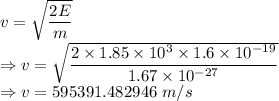
Physics, 17.03.2020 04:04 happysage12
A Van de Graaff generator is one of the original particle accelerators and can be used to accelerate charged particles like protons or electrons. You may have seen it used to make human hair stand on end or produce large sparks. One application of the Van de Graaff generator is to create x-rays by bombarding a hard metal target with the beam. Consider a beam of protons at 1.85 keV and a current of 5.15 mA produced by the generator.(a) What is the speed of the protons (in m/s)?(b) How many protons are produced each second?

Answers: 3


Other questions on the subject: Physics

Physics, 22.06.2019 02:10, kernlife
Astudent is performing an experiment comparing sound and light waves. the student gathers the following data. what conclusion does the student most likely make based on this data? light waves always travel the same speed; however, the speed of sound is determined by the medium that it travels through. all sound waves always have the same energy, so the temperature of the medium does not affect wave speed. light needs to vibrate particles, so it travels fastest in tightly packed solids, while sound does not need a medium, so it travels fastest in a gas. tightly packed particles in solids slow down the light waves; however, sound waves make particles bounce into each other, so they travel faster in solids.
Answers: 3


Physics, 22.06.2019 03:10, joho38
Athin plate moves between two parallel, horizontal, stationary flat surfaces at a constant velocity of v = 7.5 m/s. the two stationary surfaces are spaced 4 cm apart, and the medium between them is filled with oil whose viscosity is 0.9 n·s/m2. the part of the plate immersed in oil at any given time is 2 m long and 0.5 m wide. if the plate moves through the mid-plane between the surfaces, determine the force required to maintain this motion. what would your response be if the plate was 1 cm from the bottom surface (h2) and 3 cm from the top surface (h1)? if the plate moves through the mid-plane between the surfaces, the force required to maintain the motion will be n. if the plate was 1 cm from the bottom surface (h2) and 3 cm from the top (h1) surface, the force required to maintain the motion would be n.
Answers: 2

Physics, 22.06.2019 08:50, babas97
The experiment was repeated many years later but the gases were mixed in a different type of container. a white solid was obtained which was xenon fluoride. predict whether you think 1) krypton and 2) radon will react with fluorine. explain reasons for your predictions
Answers: 3
You know the right answer?
A Van de Graaff generator is one of the original particle accelerators and can be used to accelerate...
Questions in other subjects:

Mathematics, 19.01.2021 17:10

English, 19.01.2021 17:10

Mathematics, 19.01.2021 17:10

Biology, 19.01.2021 17:10

Computers and Technology, 19.01.2021 17:10













